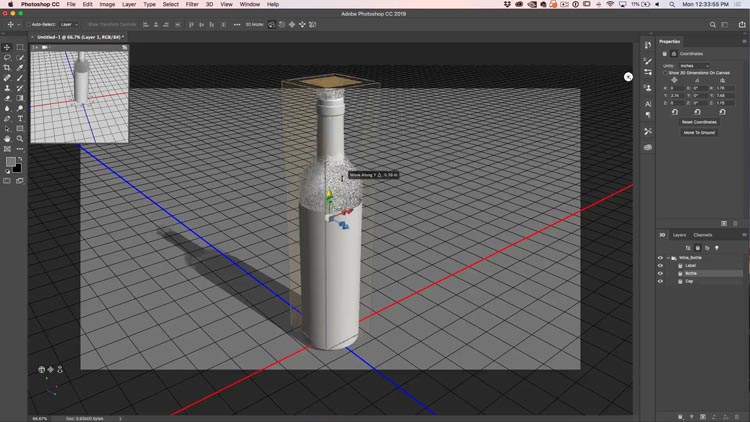How to Create and Manipulate 3D Designs in Photoshop opens the door to a world of creativity where digital artistry meets cutting-edge technology. In this guide, you’ll explore the fascinating realm of 3D design, uncovering the essential tools and techniques that enable you to transform your ideas into stunning visual masterpieces. Whether you’re a beginner or an experienced designer, this comprehensive overview will empower you to harness the full potential of Photoshop’s 3D capabilities.

From understanding the foundational principles of 3D design to mastering advanced manipulation techniques, the journey promises to enhance your skills and inspire your creativity. As we delve into the intricacies of creating three-dimensional artwork, you’ll learn how to navigate Photoshop’s powerful features, making it easier to bring your artistic visions to life.
In today’s fast-paced world, where everything seems to move at the speed of light, it’s essential to take a step back and appreciate the art of mindfulness. By focusing on being present in the moment, we can enhance our overall well-being, reduce stress, and foster a deeper connection to ourselves and others. Mindfulness is not just a trendy buzzword; it’s a powerful tool that can transform our daily lives.Mindfulness originates from ancient meditation practices, particularly in Buddhism, but has been adapted into modern therapeutic practices.
At its core, mindfulness is about being aware of our thoughts, emotions, and surroundings without judgment. This practice invites us to observe our experiences as they happen, rather than getting caught up in past regrets or future anxieties. This shift in perspective can lead to a clearer mind and a more fulfilling life.One of the simplest ways to incorporate mindfulness into your daily routine is through meditation.
Meditation does not have to be a daunting task; even a few minutes a day can make a significant difference. Start by finding a quiet space where you can sit comfortably, close your eyes, and focus on your breath. As you inhale and exhale, allow your thoughts to drift in and out like clouds passing in the sky. Whenever you find your mind wandering, gently bring your focus back to your breath.
This practice helps train your mind to stay present and enhances your ability to manage stress.Aside from traditional meditation, mindfulness can be practiced in various ways throughout the day. For instance, eating mindfully can turn a mundane routine into a pleasurable experience. Instead of rushing through meals, try to savor each bite. Notice the flavors, textures, and aromas of the food.
This simple practice can increase your appreciation for the nourishment you provide your body and help you develop a healthier relationship with food.Mindfulness can also be incorporated into daily activities such as walking, showering, or even washing dishes. The key is to be fully engaged in the activity at hand rather than allowing your mind to drift to unrelated thoughts or distractions.
For example, during a walk, pay attention to the sensations of your feet on the ground, the air on your skin, and the sounds around you. This heightened awareness can turn an ordinary walk into a refreshing and rejuvenating experience.In addition to personal well-being, mindfulness has significant benefits for interpersonal relationships. When you practice mindfulness, you become more attuned to your own emotions and reactions, which can improve your communication skills.
Being present in conversations allows you to listen actively, respond thoughtfully, and connect with others on a deeper level. This practice can foster empathy and understanding, enhancing your relationships with family, friends, and colleagues.Furthermore, mindfulness can be particularly beneficial in the workplace. In a culture often dominated by constant notifications and multitasking, taking a moment to breathe and center yourself can lead to increased productivity and creativity.
Many organizations now offer mindfulness programs as part of their wellness initiatives. These programs often include guided meditation sessions, workshops, and resources to help employees cultivate a mindful approach to their work.The practice of gratitude also complements mindfulness beautifully. By taking time each day to reflect on what you are thankful for, you can shift your focus from what’s lacking in your life to what you already have.
This simple yet powerful practice can enhance your overall sense of well-being and foster a positive mindset. Consider keeping a gratitude journal where you jot down three things you appreciate each day. Over time, you will find that this practice can help you cultivate a more optimistic outlook on life.As you embark on your mindfulness journey, it’s important to approach it with an open mind and a sense of curiosity.
There will be days when it feels challenging, and that’s perfectly normal. The goal is not to achieve a state of constant calm but to develop a greater awareness of your thoughts and emotions. Be gentle with yourself as you learn to navigate this new practice, and remember that each moment is an opportunity to start anew.In conclusion, mindfulness is a transformative practice that can enhance your quality of life in numerous ways.
By cultivating awareness and being present in the moment, you can reduce stress, improve your relationships, and foster a deeper appreciation for life. Whether through meditation, mindful eating, or simply being aware of your surroundings, there are countless opportunities to integrate mindfulness into your daily routine. So take a deep breath, embrace the present moment, and begin your journey toward a more mindful life.



